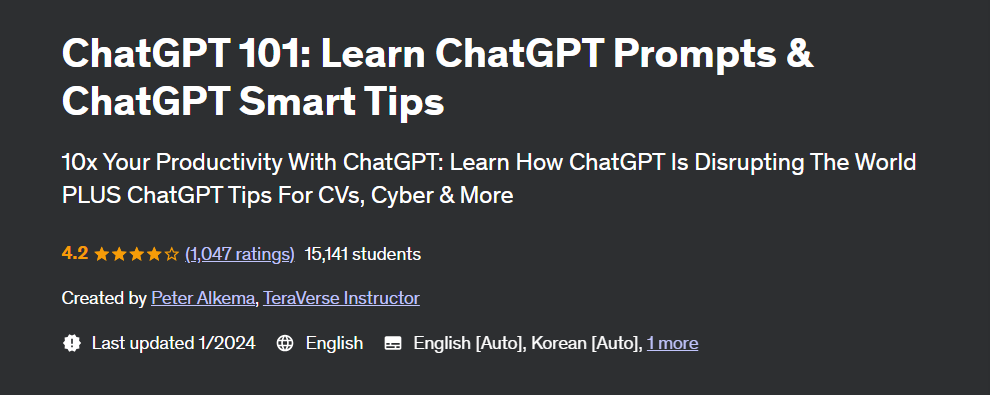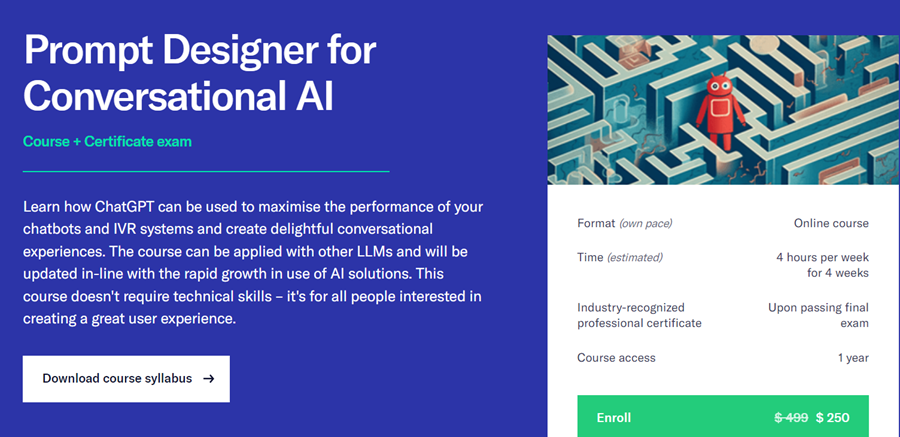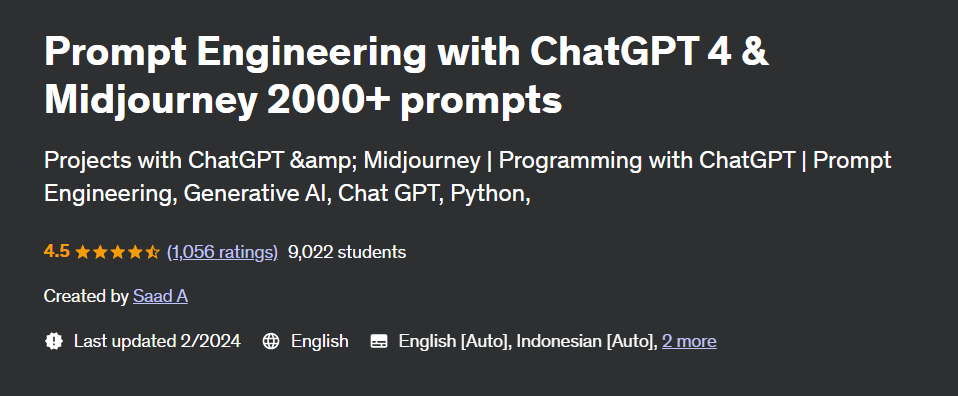Prompt engineering is a process of providing curated natural language instructions or prompts to generative AI models to get contextually relevant responses.
A prompt engineer designs and refines prompts for AI systems to generate desired responses, using techniques such as tokenization, model parameter tuning, and various prompt methods to improve output quality.
This article explores the necessary skills and career path steps to help you succeed as a prompt engineer.
What is Prompt Engineering?
Prompt engineering is the practice of creating text inputs or specific prompts to guide large language models (LLMs) powered AI bots like ChatGPT toward generating accurate and meaningful responses. Its goal is to optimize the performance of AI bots by providing them with context and information.
Prompt engineering revolves around the idea of experimenting and refining text inputs to optimize the performance of AI models. By providing clear and detailed instructions, users can guide AI bots to generate responses that meet specific criteria, such as theme, desired response length, constraints, and more. This process involves a hit-and-trial approach to understand what prompts work best for a given task.
One can also get help from tools such as AI prompt generators to get started with effective prompting.
What Does a Prompt Engineer Do?
Prompt engineers write and refine prompts to guide machine learning models into providing desired outputs. The key responsibilities of prompt engineers are listed below.
- Domain knowledge: A prompt engineer acquires adequate domain expertise for a strong grasp of related terminologies, which can have a direct impact on prompt quality.
- Crafting prompts: Writing clear-cut prompts with all the details, examples, and additional context to guide AI in the right direction.
- Optimization: A prompt engineer focuses on optimizing prompt response times and experimenting with the prompt to get increasingly refined results.
- Team collaboration: Working with cross-functional teams to get insights about model behavior, improving prompt design, and more.
- Fine-tuning, automation, etc.: A prompt engineer fine-tunes existing models by preparing custom datasets and optimizing training, auto-generates prompts for testing, and integrates AI with external and internal systems.
Essential Skills Needed to Become a Prompt Engineer
Prompt engineering is a multi-faceted career path that requires a diverse set of skills, such as an understanding of AI models, programming knowledge, domain experience, and more, as given below.
AI/ML/NLP Understanding
A general understanding of how AI (artificial intelligence), ML (machine learning), and NLP (natural language processing) technologies work in an LLM context helps a professional efficiently function as a prompt engineer.
Coding Proficiency
Prompt engineers need strong coding skills to write and test code for AI, ML, and NLP systems. Programming skills are also useful for automated prompt generation, integrations, fine-tuning, and debugging, providing additional value beyond standard prompt writing and leading to high-paying job opportunities.
Domain expertise
Prompt engineering requires knowledge of domain-specific terminologies that can give an edge to prompt engineers. While one can search online for technical jargon, having subject matter expertise is crucial for effective application in AI and prompt refinement.
Communication skills
A prompt engineer needs to effectively communicate the prompts to the AI. The instructions should clearly define the objectives while giving necessary details and avoiding anything that can confuse the LLM. Since this role can entail inter-department collaboration, having strong verbal communication is another crucial requirement.
Data analysis
Prompt engineers work with large datasets to develop prompts for AI and ML models. They need strong data analysis skills to evaluate the accuracy, quality, and bias of model outputs and provide feedback for fine-tuning AI.
Creativity & critical thinking
Creating effective prompts requires a combination of creativity and critical thinking. Prompting involves creatively pushing LLMs to respond sensibly by adjusting prompts to achieve the desired output. Critical thinking is key for prompt analysis, pattern identification, troubleshooting, and ethical considerations.
Step-by-Step Guide to Become a Prompt Engineer
Making a career in prompt engineering needs one to excel in different categories like strengthening AI basics, gaining technical expertise, and a few more, as given below.
Build a Strong Foundation
One should start by learning the basics of artificial intelligence and how natural language processing works with large language models. Getting acquainted with deep and machine learning will also help build a career in this domain. In addition, try these tools yourself to get crucial input about how it works in real-time.
Gain Technical Expertise
Most LLMs are built over Python. So, it will be a good thing to learn Python programming, which can prove handy for using LLMs for further integrations, fine-tuning, etc. This entails learning the coding basics and experimenting with Python libraries such as TensorFlow, Pytorch, and Hugging Face Transformers. One can start with courses at e-learning platforms like Udemy or even at social media sites like YouTube.
Immerse Yourself in Prompt Engineering
Deep dive into the fundamentals of designing effective prompts. Also, check various prompting strategies, including zero shot, few-shot, meta prompting, etc., with different generative AI tools, such as ChatGPT, Gemini, and Claude.
Every AI model has some unique attributes, owning to their training data and style. Understanding how they respond to prompts will certainly offer valuable insights for aspiring prompt engineers.
Initiate Personal Prompt Engineering Projects
Leverage prompt engineering techniques to build small-scale personal projects, such as text-generating chatbots in the domain of your interest. One can do this with a comparatively small dataset, which will give critical insights into the model working and how data bias can possibly affect AI responses.
Try fine-tuning the model and document the progress. One should consider sharing the process with the communities at GitHub, Reddit, and elsewhere to get feedback.
Attend Conferences and Workshops & Contribute to Open-Source Projects
Conferences and workshops offer a great opportunity to learn from experts and network with peers. These events also help learn from the latest developments in the AI/ML/NLP domain and also open up options for future collaboration.
Likewise, contributing to open-source projects dedicated to prompt engineering and NLP can develop your own skills and benefit the community, too.
Learn Prompt for AI Tools with the Best Courses
Geekflare has researched and compiled the best courses to help you become a successful prompt engineer.
ChatGPT 101: Learn ChatGPT Prompts & ChatGPT Smart Tips
ChatGPT 101 introduces AI technological disruption, more specifically, the impact of large language model-based tools like ChatGPT. Besides, the candidates will learn to use ChatGPT to its full potential for automating menial tasks and boosting creativity. Lastly, the course also covers ChatGPT limitations for a realistic day-to-day implementation.
Also Explore: Best ChatGPT Courses

- Key Topics: Introduction to ChatGPT, ChatGPT demo, Prompts for various use cases, ChatGPT limitations.
- Creator: Peter Alkema, TeraVerse Instructor
- Course Duration: 62 sections, 302 lectures (18 hours 11 minutes)
- Platform: Udemy
- Pricing: $17.99
Prompt Designer for Conversational AI
Prompt Designer for Conversational AI is for beginners trying to leverage ChatGPT-like tools to optimize their chatbots and IVR systems to improve the end-user experience. The course also helps candidates unearth ChatGPT use cases, create useful prompts, and develop conversational AI.

Key Topics: ChatGPT for chatbot creation, developing AI personalities with ChatGPT, designing usable dialogues, enriching chatbots, content creating training phrases
- Creator: Hans van Dam
- Course Duration: 4 weeks (4 hours per week)
- Platform: Conversation Design Institute
- Pricing: $250
Prompt Engineering with ChatGPT 4 & Midjourney 2000+ prompts
Prompt Engineering with ChatGPT 4 & Midjourney course is about using generative AI tools like ChatGPT and Midjourney for content creation, implementing SEO techniques, affiliate marketing, business planning, career development, selling AI-generated art, email, and social media marketing.
Also Read: How to Write Midjourney Prompts

Key Topics: Generative AI, ChatGPT Playground, prompting techniques, LLM vs search engine, Bing AI, Midjourney introduction, prompts, & parameters, ChatGPT content creation.
- Creator: Saad A
- Course Duration: 24 sections, 122 lectures (13h 56m)
- Platform: Udemy
- Pricing: $13.99
Introduction to Prompt Engineering for Generative AI
Introduction to Prompt Engineering is an entry-level course that starts with an introduction to LLMs, NLP, and prompt engineering. It also illustrates operating generative AI software like ChatGPT, DALL-E, and Midjourney and covers advanced concepts such as fine-tuning and interacting LLMs with an API.
Key Topics: LLMs, ChatGPT, AI image generation, DALL-E, Midjourney, prompt fine-tuning, API usage.
- Creator: Ronnie Sheer
- Course Duration: 44 minutes
- Platform: LinkedIn
- Pricing: Free
ChatGPT Prompt Engineering Course
ChatGPT Prompt Engineering is an introductory course comprising the basics of AI, NLP, GPT, and LLM. The video lesson also covers prompt engineering, creating effective prompts, and its advanced types. Finally, the course concludes with important parameters specific to the OpenAI playground, such as temperature, etc.
Key Topics: Introduction to generative AI terminologies, prompt engineering, types of prompts, and factors affecting NLP models.
- Creator: Hasan Aboul Hasan
- Course Duration: 30 mins
- Platform: YouTube
- Pricing: Free
Industries Hiring Prompt Engineers
Major industries are going through AI integrations in their workflows. As per a McKinsey research, generative AI can infuse up to $4.4 trillion into the global economy. Across sectors, these technologies can help automate 70% of the average employee’s routine work.
According to McKinsey’s report “The state of AI in 2023: Generative AI’s breakout year,” only 7% of organizations adopting AI are currently hiring for prompt engineering roles. This indicates that prompt engineering is a small segment within the larger gen AI landscape. However, experts believe that this field has the potential for significant growth in the future.
Generative AI is expected to have a significant impact across various industries. According to McKinsey research, the banking sector could potentially see an increase of $200 to $300 billion in annual revenues due to the productivity boost provided by AI, estimated at 2.8 to 4.7 percent.
Gartner predicts up to 30% of outbound marketing by large organizations will be based on generative AI. Likewise, we are about to witness a major blockbuster movie with up to 90% AI-generated content by 2030.
Glassdoor reports show that prompt engineers in the US make a base salary of $87K – $145K per year. This suggests that prompt engineering is a stable and growing field. It is likely to continue evolving in the future, but AI influence will remain significant across industries.
Types of Prompts
Based on instruction style and format, there are various prompt types, such as zero-shot, few or multi-shot, chain of thought, audio prompts, and more, as listed below.
Zero-shot prompting
Zero-shot prompting is directly instructing the AI to perform tasks without any additional context or examples. This works well for elementary tasks.
Few shot prompting
Few shot prompting refers to giving examples (called “shots”) in the prompt itself. This technique is recommended for slightly complicated tasks and gives more accurate results.
Chain-of-Thought prompting
Breaking down complex tasks into smaller, connected sub-tasks can help increase the accuracy of LLM responses that require advanced reasoning. This approach allows the model to build on previous solutions and reach the final output gradually.
Prompt engineers can check the outputs of each step and provide feedback to gradually attain maximum accuracy.
Self-refine prompting
The self-refine prompting style involves a cycle of input-output-self-critique-refine-output for the AI. This process continues until the model meets a user-defined condition, such as a set number of outputs or a specific time limit.
Audio prompts
Audio prompts are suitable for newer AI applications accepting multi-modal input. They can be helpful in tasks like music composition and voice recognition, as they provide instructions using sound as a medium alongside or instead of text prompts.
Frequently Asked Questions
Prompt engineering fosters an in-depth understanding of the AI model at hand, with the end goal of getting better outputs and greater user satisfaction.
Prompt engineering is a full time career as of now, with various job boards listing vacancies. However, some experts only see it as a supplement skill in the future needed for a broader job profile involved in AI development and interaction.
There isn’t a universal answer to this question, as the salary largely depends on the candidate’s location, industry, and expertise. For instance, prompt engineers in the US are paid in the range of $87K – $145K per year, whereas for the UK, this figure is notably lower at £39K – £71K, per Glassdoor.

